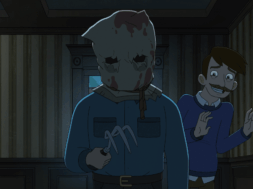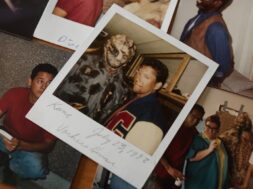Larry Cohen’s ‘A Return to Salem’s Lot’ and Its Surprising Parallels to ‘Midsommar’ [Editorial]
Movies about know-it-all urbanites who travel to a strange place and get what’s (violently) coming to them are nothing new in the horror world. You can trace the roots at least as far back as Jonathan Harker’s naive journey into the mountains of Transylvania, where the locals all warned him away from the Borgo Pass – and especially Dracula’s Castle – only to see him wander off anyway, in search of wealth. He got what was coming to him.
The problem with stories like that, today, is that we live in a world where people have seen horror movies. So we have at least a passing awareness that if we go to a weird place full of cultists, we should be on the lookout for red flags. That’s why a film like Ari Aster’s Midsommar, about a group of Americans who wander into an ancient Swedish festival where death is foreshadowed everywhere you look, has to come up with a clever way to keep the heroes in harm’s way without making them look like total idiots.

The conceit writer/director Aster settled on was to make his most of his protagonists anthropology students, who are so fascinated by the strange and sometimes horrifying society in which they find themselves that they feel compelled to catalogue it instead of running away. Their need for knowledge overshadows their urge for self-preservation. They’re not exactly “wise,” but at least we understand what drives them to stay in this creepy town where everyone keeps disappearing under mysterious circumstances and the murals on every wall tell a scary story about what fate will befall our heroes.
Not to take anything away from Aster, who is as noteworthy a horror auteur as any filmmaker to come along in the last several years, but that right there is a storytelling device which will be very familiar to anyone who saw and respected Larry Cohen’s A Return to Salem’s Lot.
Which is, admittedly, not many people.

Cohen, the writer/director of horror classics like It’s Alive and Q The Winged Serpent, was enlisted to make a sequel to Salem’s Lot, Tobe Hooper’s successful mini-series adaptation of Stephen King’s classic vampire novel, and that’s what he did… kind of. Cohen abandoned the plot and obvious sequel tease from the original in favor of an all-new story about a community of vampires living in secret in New England, having arrived just before the Mayflower, and having achieved in the centuries that followed a secretive, uneasy equilibrium with the rest of American society.
The story kicks off with anthropologist Joe Weber (Michael Moriarty) in the middle of the jungle, witnessing a human sacrifice and feeling absolutely nothing about it. His cameraman is shocked and horrified but Joe argues that if the situation were reversed, and this culture saw what Americans did to their own criminals, they would be equally repulsed. It’s the exact same argument Christian (Jack Reynor) makes to Dani (Florence Pugh) after they witness a ritualistic suicide in Midsommar. Who are we to judge, when morality itself is relative?
That’s a mentality that gets explored in both Midsommar and A Return to Salem’s Lot, but Cohen’s film is more confrontational about it. Joe returns to America to take care of his son, who has severe discipline problems, and takes him to a house he inherited up in Salem’s Lot. While there they notice that there’s hardly anyone around in the day, and the whole place lights up at night. Nothing suspicious here!

When a group of punks get pulled over by the cops and attacked by the local vampires, the survivor escapes to Joe’s house and the three of them visit Judge Axel (Andrew Duggan), who whisks her away to be killed, and sends Joe’s son Jeremy (Ricky Addison Reed) off to a local wedding along with a girl who is seemingly his age named Amanda (Tara Reid, in her motion picture debut).
Ordinarily a film about “normal” people finding their way into a cultlike, terrifying community would take its sweet time before revealing the horrible truth. Midsommar certainly does. But Larry Cohen isn’t interested in the inevitable reveal; he’s interested in the conversation that comes after all the secrets are out in the open. So at a very early point in A Return to Salem’s Lot the curtain gets raised. Joe finds out the town is full of vampires, that the woman he saved is being killed by little old lady vampires in the kitchen. Even Jeremy finds out the truth, when the wedding is revealed to be between two kids who, as vampires, are presumably much older than they look.

In Midsommar, the anthropology angle is largely an excuse to keep the protagonists in a scary place long after common sense would make them want to leave. (Ari Aster even said so.) But in A Return to Salem’s Lot, anthropology is the entire point of the story. The vampires in Salem’s Lot brought Joe here, specifically, to write about their culture and give it the objective respect they think it deserves after centuries of non-stop demonization. They don’t want to hurt Joe or his son, they want them to be happy here, to only see the best in them. They may be vampires, but they can’t be ALL bad… can they?
The vampires tempt both the Weber men with romantic attachments, and Joe – being morally compromised from the get-go and willing to forgive anything if he can rationalize it – quickly starts having an illicit, creepy affair with a teenage-looking vampire. That’s another parallel with Midsommar, where the looser morality of this new culture gives the morally ambiguous male lead, Christian, an excuse to engage in sexual activities that would be completely inexcusable in any other environment, and in which he only engages now because this new culture permits it.

This culture is bloody and disgusting and flies in the face of every moral stance in western culture, but who are we to judge, A Return to Salem’s Lot asks? Isn’t their culture as valid as any other? Do they not deserve to live and love and to be part of this world? It’s a disturbing question that Ari Aster raises and never really comes back around to, but which Cohen answers, extremely clearly, halfway through the film when acclaimed director Samuel Fuller shows up, chomping a cigar, and looking for Nazis.
That’s right, the director of classic, no-punches-pulled motion pictures like Shock Corridor and The Naked Kiss plays a Nazi-hunting vigilante who, upon discovering that Salem’s Lot is full of vampires, proceeds to physically knock some sense into the whole Weber family. He slaps Jeremy around until he stops screaming his brainwashed rationalizations and convinces Joe they have to kill all the vampires, because there’s no damned academic excuse for killing anybody. You can argue the moral grey areas all you want but on some level, Cohen’s film argues that you have to draw the line and say “That’s not a culture, that’s just an excuse for mass murder.”

Actually, it’s an excuse for a lot more. Over the course of A Return to Salem’s Lot we learn more and more about vampire culture, including the fact that they employ “drones” (a term which, we learn, is considered racially-charged) to protect them during the day. This underclass is completely trapped by social subjugation and, often, physical abuse. It’s no coincidence that the vampires are revealed to be colonial Americans, and that many of them probably came over in those early days of western expansion. A Return to Salem’s Lot draws a clear connection between vampirism and the evils of manifest destiny and slavery, and directly accuses the rich and powerful, today, of profiting off of the abuse, dehumanization and murder of other human beings for centuries.
In other words, in A Return to Salem’s Lot, we are told to think of vampires as a legitimate, valid culture. Then we are told that they are not, that they are as bad as the Nazis, but that they also represent the founding fathers of America. That’s exceptionally heavy stuff for a low budget sequel to a TV mini-series that barely got released in theaters and which almost nobody remembers today. And it’s arguably more challenging – from anthropological and an ethical perspective – than Midsommar, at least as far as this subplot goes.
The problem with A Return to Salem’s Lot is that, no matter how intelligent its ideas are and no matter how fascinating its structure is, it’s not a very well made film. The cast is incredibly uneven, with Ricky Addison Reed shouting almost all of his lines and Michael Moriarty – a Larry Cohen regular, and normally an excellent actor – shouting all his own lines back, presumably to compensate for Reed’s strangely boisterous energy. The makeup effects are sometimes laughable, and the whole movie is too danged slow for its own good. There’s a reason most people have never heard of it. Midsommar is the superior visceral and emotional experience, that’s for sure, with more skillful cinematography, pacing and mood, and exceptional performances across the board.
But A Return to Salem’s Lot has something Midsommar doesn’t, and that’s a certain narrative daring. Midsommar falls into very familiar rhythms, evoking genre mainstays like The Texas Chain Saw Massacre and The Wicker Man and sometimes practically to the letter. Cohen’s film eschews all audience expectation and travels into more intellectual, unexpected narrative directions, with big ideas that warrant lengthier discussion than one might normally expect from a forgotten, neglected Stephen King sequel that has nothing to do with the original novel.
And of course, it gave us Samuel Fuller as a cigar-chomping, Nazi-killing vampire hunter, all grumpy and self-assured, half-funny and all badass. Midsommar, for all its fineries, for all its horrors, cannot make that claim. And that, surely, is to its (relatively minor) detriment.










